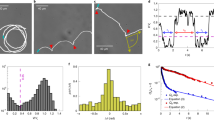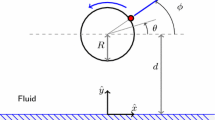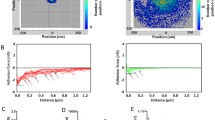Abstract.
Gliding and near-surface swimming of microorganisms are described as a mobile form of microbial adhesion that need not necessarily be reversible. It is argued that the reversibility of microbial adhesion depends on the depth of the secondary interaction minimum, calculated from the forces between an organism and a substratum acting in a direction perpendicular to the substratum surface. The mobility of adhering microorganisms depends on lateral interactions between the organisms. On ideally homogeneous and smooth model surfaces, only mobile adhesion occurs because the multibody, lateral interactions are weak compared with the thermal or Brownian motion energy of the organisms. Minor chemical or structural heterogeneities, which exist on all real-life surfaces, yield a lateral interaction on adhering microorganisms. This causes their immobilization, which helps to explain the physicochemical nature of microbial gliding or near-surface swimming. Moreover, these lateral interaction energies are one order of magnitude smaller than the Lifshitz-Van der Waals, electrostatic, and acid-base forces acting perpendicular to substratum surfaces that are responsible for adhesion.
Similar content being viewed by others
Author information
Authors and Affiliations
Additional information
Received: 2 April 1998 / Accepted: 26 May 1998
Rights and permissions
About this article
Cite this article
Busscher, H., Poortinga, A. & Bos, R. Lateral and Perpendicular Interaction Forces Involved in Mobile and Immobile Adhesion of Microorganisms on Model Solid Surfaces. Curr Microbiol 37, 319–323 (1998). https://doi.org/10.1007/s002849900385
Issue Date:
DOI: https://doi.org/10.1007/s002849900385




